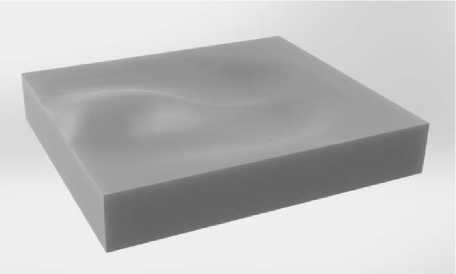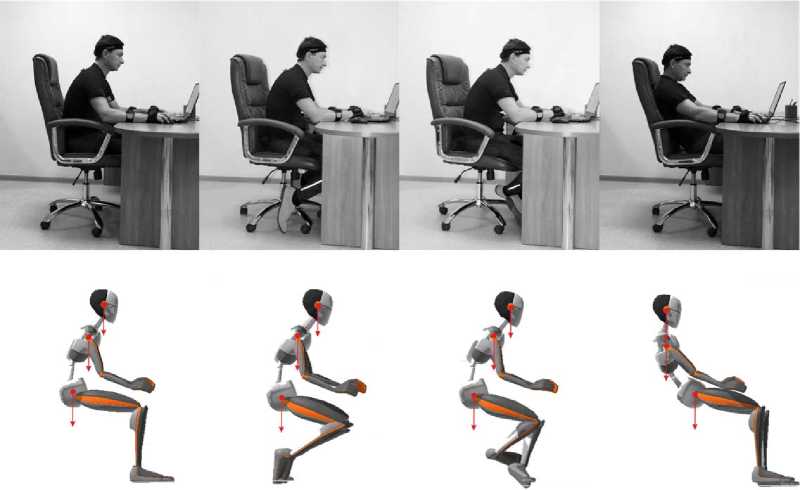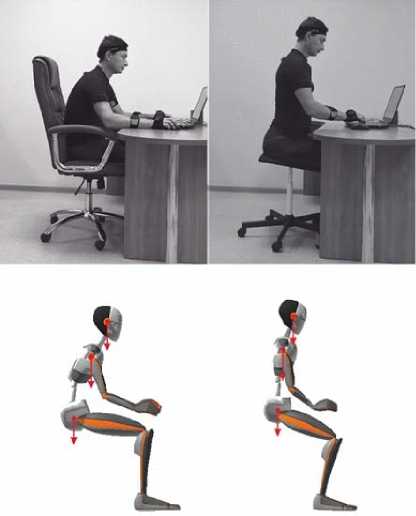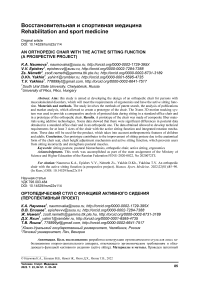An orthopedic chair with the active sitting function (a prospective project)
Автор: Naumova K.A., Epishev V.V., Nmeth Zs., Yakhin D.Kh., Yakhina T.V.
Журнал: Человек. Спорт. Медицина @hsm-susu
Рубрика: Восстановительная и спортивная медицина
Статья в выпуске: S1 т.22, 2022 года.
Бесплатный доступ
Aim: this study is aimed at developing the design of an orthopedic chair for persons with musculoskeletal disorders, which will meet the requirements of ergonomics and have the active sitting function. Materials and methods. The study involves the methods of patent search, the analysis of publications and market analysis, which allowed to create a prototype of the chair. The Xsens 3D motion tracking system was used to provide a comparative analysis of postural data during sitting in a standard office chair and in a prototype of the orthopedic chair. Results. A prototype of the chair was made of composite fiber materials using additive technologies. Xsens data showed that there were significant differences in postural data obtained in a standard office chair and in an orthopedic one. The data obtained allowed to develop technical requirements for at least 3 sizes of the chair with the active sitting function and integrated rotation mechanism. These data will be used for the product, which takes into account anthropometric features of children and adults. Conclusion. Our prototype contributes to the improvement of sitting posture due to the anatomical form of the chair seat, chair height adjustment mechanism and active sitting function, which prevents users from sitting incorrectly and strengthens postural muscles.
Sitting posture, postural biomechanics, orthopedic chair, active sitting, ergonomics
Короткий адрес: https://sciup.org/147238198
IDR: 147238198 | УДК: 796.093.484 | DOI: 10.14529/hsm22s114
Текст научной статьи An orthopedic chair with the active sitting function (a prospective project)
К.А. Наумова1, ,
В.В. Епишев1, ,
Ж. Немет2, ,
Д.Х. Яхин1, ,
Т.В. Яхина1, , 1Южно-Уральский государственный университет, Челябинск, Россия 2Печский университет, Печ, Венгрия
Introduction. Back pain is a significant medical problem [2, 9] but its mechanism is poorly understood, and there are no effective solutions to prevent its occurrence or to provide effective long-term treatment [6, 8].
In recent years, indirect evidence has emerged to suggest that the standard design of office chairs is the root cause of back pain [4]. In some cultures, mainly oriental, there are alternative traditional sitting postures that reduce the number of diseases of the spine [5]. Therefore, alternative design solutions for office chairs have been developed: a saddle chair, a knee chair, etc. However, despite the obvious advantages, a significant drawback remains, which consists of the longterm maintenance of a static position [7].
This disadvantage can be eliminated by the concept of active sitting, when the seat of a chair is movable, which allows both to constantly monitor postural balance and to strengthen postural muscles, while performing sitting exercises [12]. The effectiveness of this approach was first shown as part of the implementation of the Rodeo chair program into the educational institutes of Norway.
In recent years, this concept has been actively developed, and new products have appeared on the market:
– Wellness Ball Active Sitting [14];
– Luna Standing Desk Stool [10];
– Balance ball chairs [3];
– QOR360 Active Chairs [11];
– SitTight Active Sitting Chair [13];
– Dancing chair [1], etc.
Therefore, taking into account the increase in sedentary time, in the coming years, a remarkable increase of interest in office ergonomics can be expected followed by the replacement of traditional office chairs with brand new models, including those with the active sitting function.
The project is aimed at developing the design of an orthopedic chair with the active sitting function and assessing its effectiveness in practice. In addition, the most efficient technology for its small-scale and large-scale production will be evaluated.
Aim. The aim of this study is to develop an orthopedic chair for people with musculoskeletal disorders that meets ergonomic requirements and has the active sitting function.
Materials and methods. The paper involves such methods as patent search, analysis of scientific publications, and market analysis. Based on the data obtained, our design specification was developed, which required using the following technological operations: creating a plaster model of the buttock and thigh area of a seated person; covering the model with a composite material to obtain an anatomical chair seat; integrating a rotation mechanism into the chair seat to provide movement in two planes (X and Y); selecting a 4-star swivel base for a chair with a chair height adjustment mechanism (Z); assembling the first prototype of the chair. The Xsens 3D motion tracking system allowed us to provide a comparative assessment of the location of body segments during sitting in a standard office chair and in our prototype.
Results. The patent search, analysis of scientific publications, and market analysis showed that the development of non-standard solutions for office and orthopedic chairs was a global trend aimed at reducing the static load on the spine during sitting. The existing solutions have a number of disadvantages:
– Wellness Ball Active Sitting, Balance ball chairs – lack of a chair height adjustment mechanism and anatomical seat;
– Luna Standing Desk Stool – non-anato-mical rigid seat;
– QOR360 Active Chairs – expensive, with a non-anatomical seat and limited seat movements (no forward tilt movement);
– SitTight Active Sitting Chair - expensive, a non-anatomical rigid seat;
– Dancing chair (utility model patent No. 65356 Removable seat) – non-anatomical seat, chair movements are limited to changes within 15 degrees.
Based on the results obtained, the following technical requirements for a prototype were identified:
-
1. An anatomical seat that promotes uniform distribution of body weight due to the increased support area;
-
2. A mechanism, which will prevent the use of wrong sitting positions (when a person tries to cross his/her legs during sitting, the seat will tilt to the left so to prevent this person from acting this way), allow to perform pelvic tilt exercises and ensure a neutral position of the pelvis for optimal ergonomics.
The plaster model of the buttock and thigh area was created followed by a 3D scanning procedure to obtain a 3D model of the anatomical seat using the SolidWorks software (Fig. 1).
Subsequently, a master model of the seat was made with CNC tools. A prototype of the seat with the integrated rotation mechanism, which provides movement of at least 28 degrees in two planes (X and Y), was made manually using the master model and composite fiber materials. A 5-star swivel base was selected for the chair to provide chair height adjustment movements (Z). The anatomical seat was covered with foam rubber and furniture fabric and then assembled with the bottom part (Fig. 2).

Fig. 1. A 3D anatomical seat model
To obtain objective information about the location of body segments during sitting, the Xsens 3D motion tracking system was used. 16 inertial sensors were placed at different areas of the body and transmitted real-time data to the MVN Analyze Software. Working conditions while sitting in a standard office chair were simulated in 4 comfortable positions (Fig. 3). Then the office chair was replaced with a prototype, and the data about the location of body segments were recorded and compared with baseline data (Fig. 4).
As can be seen from Figures 3 and 4, the differences in the location of body segments depending on the sitting posture and chair technology are obvious. Therefore, it can be said that this type of chair makes the user sit correctly, while the swivel joint ensures forward tilts, provides pelvic stability, and maintains lumbar lordosis.

a) b) c) d)
Fig. 2. A prototype of the chair: a – front view, b – maximum tilt to the right, c – maximum tilt to the left, d – side view

Fig. 3. The location of body segments in various sitting positions while sitting in a standard office chair (arrows indicate gravity)

Fig. 4. The location of body segments in various sitting positions while sitting in a standard office chair (left image) compared to our anatomical chair prototype (right image)
Based on the data obtained, the following technical requirements were formulated for the further development of the project:
-
1. Create three standard sizes of the anatomical seat:
– for people over 90 kg, 495×445 mm;
– for people 40–90 kg, 470×330 mm;
– for people 20–39 kg, 370×330 mm.
-
2. Find the optimal chair bottom to ensure reliable chair height adjustment;
-
3. Select technologies for small-scale production that provide a market price of no more than 200 US dollars.
Conclusion. As part of the research and development project, a prototype of the orthopedic chair with the active sitting function was made.
The use of the Xsens 3D motion tracking system and the corresponding software allowed to identify significant differences in the location of body segments depending on the chair used. Further research and development activities aimed at the creation of various seat sizes will allow to launch a commercially successful product and reduce the number of people suffering from back pain.
Список литературы An orthopedic chair with the active sitting function (a prospective project)
- Tantsuyushchiy stul [Dancing chair]. Available at: https://www.dancingchair. ru/collection/kupit-ortopedicheskij-stul-dlya-vzroslyh-tancuyushchij].
- Balague F., Mannion A.F., Pellise F. Non-Specific Low Back Pain. The Lancet, 2012, vol. 379 (9814), pp. 482-491. DOI: 10.1016/S0140-6736(11)60610-7
- Balance Ball Chairs. Available at: https://www.gaiam.com/collections/active-sitting.
- Bendix T. Low Back Pain and Seating. In Hard Facts about Soft Machines, 2020, pp. 147-155. DOI: 10.1201/9781003069461-16
- Bontrup C., Taylor W.R., Fliesser M. et al. Low Back Pain and Its Relationship with Sitting Behaviour Among Sedentary Office Workers. Applied Ergonomics, 2019, vol. 81, pp. 102894-102899. DOI: 10.1016/j.apergo.2019.102894
- Clark S., Horton R. Low Back Pain: a Major Global Challenge. The Lancet, 2018, vol. 391 (10137), pp. 2302-2318. DOI: 10.1016/S0140-6736(18)30725-6
- De Souza I.M.B., Sakaguchi T.F., Yuan T.F. Prevalence of Low Back Pain in the Elderly Population: a Systematic Review. Clinics, 2019, vol. 74, pp. 86-96. DOI: 10.6061/clinics/2019/e789
- Hartvigsen M.J., Hancock M.J., Kongsted A. What Low Back Pain is and why we Need to Pay Attention. The Lancet, 2018, vol. 391 (10137), pp. 2356-2367. DOI: 10.1016/S0140-6736(18)30480-X
- Hoy D., Brooks P., Blyth F. The Epidemiology of Low Back Pain. Best Practice & Research Clinical Rheumatology, 2010, vol. 24 (6), pp. 769-781. DOI: 10.1016/j.berh.2010.10.002
- Luna Standing Desk Stool. Available at: https://www.fully.com/en-gb/chairs/luna-standing-desk-stool.html.
- QOR360 Active Chairs. Available at: https://qor360.com/shop-active-chairs.
- Shen Z., Wan X., Jin Y. SeatPlus: A Smart Health Chair Supporting Active Sitting Posture Correction. In International Conference on Human-Computer Interaction, 2021, pp. 531-547. DOI: 10.1007/978-3-030-78224-5_37
- SitTight Active Sitting Chair. Available at: https://stacksocial.com/sales/sittight.
- Wellness Ball Active Sitting. Available at: https://www.technogym.ru/articles/wellness-ball-active-sitting.


